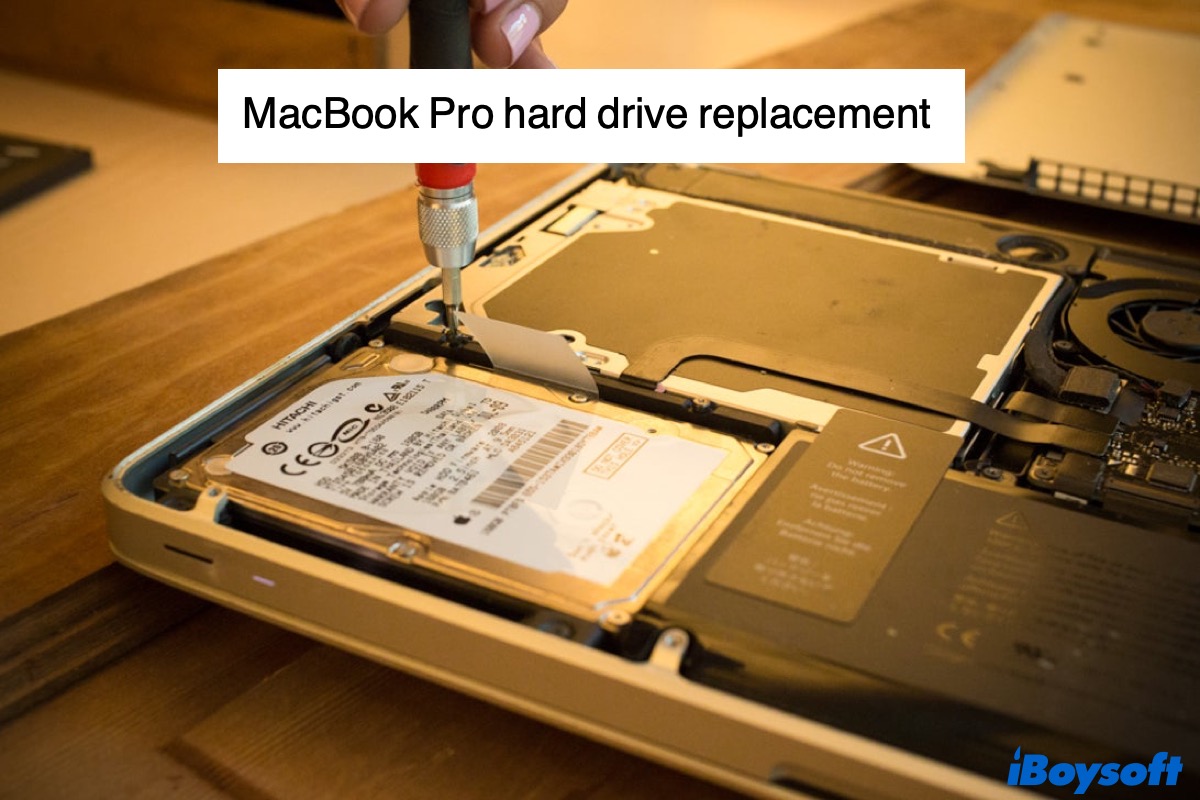Is your MacBook Pro running slower than it used to? When you run into unresponsive programs frequently or can't open files as you should, you know it's time to upgrade the hard drive on your Macbook Pro. But the question is, can your MacBook Pro model be upgraded?

Can you upgrade MacBook Pro hard drive?
When Mac can't serve you as fast and efficient as it was due to storage shortage, you can either upgrade the hard drive on your MacBook Pro, use an external storage device, or get a new one. Moving some big files to an external hard drive seems fine but doesn't solve the real problem.
The ideal is to perform MacBook Pro hard drive replacement. However, Apple has tactically made its RAM and SSD un-upgradeable and unreplaceable to boost the sales of new Macs. If you are using one of the old Mac Models, you may still stand a chance to get the hard drive replaced.
You can check what year your MacBook Pro is by clicking the Apple logo > About This Mac to see whether it can be upgraded.
Mac Models that are eligible for hard drive replacement:
- MacBook Pro with Retina display (2015 and older)
- MacBook Pro without Retina display (late 2016 and older)
- MacBook Air up to 2017
- MacBook up to 2010
MacBook Pro hard drive replacement cost:
If you take your MacBook Pro to a professional technician for hard drive replacement, they charge a service fee of around $80/hour (usually 3-4 hours with backup), plus the parts (about $260 for 1T SSD). But you can save hundreds of dollars by doing it yourself.
- If your MacBook Pro is on the list and facing problems described in the next part, read to learn how to remove the hard drive from your MacBook Pro.
- If your Mac isn't upgradeable, you can add storage to your MacBook Pro by using external hard drives or SD cards if you have an SDXC port. You can also make use of cloud storage.
When should you upgrade/replace a MacBook Pro hard drive?
Here are the signs that you need a MacBook Pro hard drive replacement:
- Battery health shows abnormal status. (How to check Macbook Pro's battery health?)
- The MacBook Pro constantly reminds you that the startup disk is full.
- The MacBook Pro boots up slowly and is often unresponsive.
- Missing or corrupted files.
Suppose your MacBook Pro is experiencing these symptoms or that you simply want to increase the storage capacity to boost your device's performance to work with resource-intensive tasks like video editing. Follow the instructions below to upgrade to a new hard drive.
How to upgrade your MacBook Pro hard drive?
The difficulty of MacBook Pro hard drive replacement varies in models. To avoid tampering with the motherboard, consider having a more qualified friend do it for you or go to the professionals if you are not very good at technical stuff.
Before opening the back cover of your MacBook Pro, make sure you've got what you need:
- A proper SSD for your model
- Screwdrivers ( one Phillips and one Torx)
- A spudger
Last but not least, back up your hard drive with Time Machine.
How to remove the hard drive from your MacBook Pro and install a new SSD?
After finishing the backup, you can follow the step below to remove the hard drive from a MacBook Pro:
- Turn off your Mac and unplug the power.
- Wait for at least 30s, then flip the MacBook Pro onto a hard and flat surface.
- Remove the screws on the back panel with a Phillips #000 screwdriver.
- Then place the screws next to the hole it belongs to avoid mixing them up because some are longer than others.
- Remove the back cover by inserting a spudger or a thin piece of plastic into the case and vent gap.
- Disconnect the battery from the motherboard. It's usually black and resides at the edge of the motherboard. Lift it using your finger or a spudger.
The following steps differ among different models.
MacBook Pro 2013-2017 hard drive replacement: need a nvme SSD adapter that costs around $20
- Use the T5 screwdriver to remove the single screw on the SSD, then slide the SSD out.
- Place the adapter to where the SSD stayed, then the SSD. If your SSD adapter can directly connect to the SSD, combine them first, then install the SSD to the Mac.
- Put back the screw. Then move on to step 15.
MacBook Pro 2009-2012 hard drive replacement: upgrade from HDD to SSD
- Remove the screws holding the hard drive. The hard drive is often located in the bottom left corner, often labeled with information such as storage and capacity.
- Unscrew the two black Phillips screws on the black bar, then pull it off and set it aside.
- Pull the plastic tab to take out the hard drive. There's maybe another SATA ribbon attached to the hard drive. Wiggle the connector to detach the hard drive.
- Remove the mounting/Torx screws from the old drive.
- Put the mounting/Torx screws from the old hard drive into the sides of the new SSD.
- Connect the ribbon cable connector to the SSD.
- Put the SSD in place. One side first, then the other.
- Add the black bar to the SSD, then secure it with the Phillips screws.
- Reconnect the battery.
- Check if the new drive works before putting it on the bottom cover.
- Screw back the bottom cover.
How to restore data to the new SSD?
Now that your new SSD is set in place, you need to boot into Recovery Mode to format the new startup drive. Then restore your macOS from the Time Machine backup and choose the new SSD as the destination. If you don't have Time Machine backup available, you can reinstall macOS.